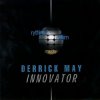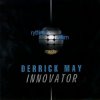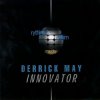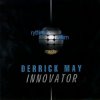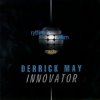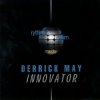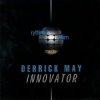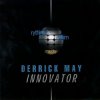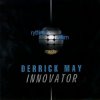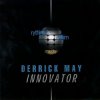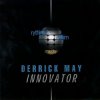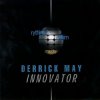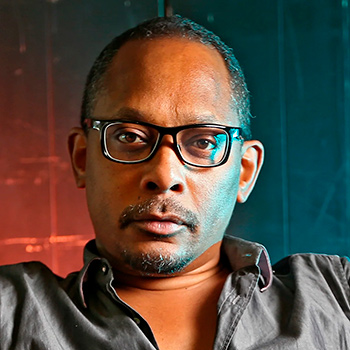
Derrick May (full name — Derrick Leonard May; born April 4, 1963) is an American DJ, producer, and one of the three central architects of Detroit techno alongside Juan Atkins and Kevin Saunderson. In music history he is known as a visionary of futuristic electronic sound, the author of “Strings of Life,” and a leading figure of the Belleville Three — the trio that helped define the face of modern techno.
Early years
Derrick May grew up in Detroit, a city of industrial decline and auto plants. That stark urban backdrop shaped his artistic worldview: music became an emotional response to a mechanical environment. As a teenager May met Juan Atkins and Kevin Saunderson — a bond formed around a shared love of European synthesizer music that sparked a historic alliance.
Early influences:
-
Parliament-Funkadelic
-
Yellow Magic Orchestra
-
early synth-pop
Belleville Three
The term “Belleville Three” refers to the Atkins–May–Saunderson trio — classmates from a Detroit suburb who together:
-
defined techno’s very language,
-
set out its philosophy,
-
and established its first production standards.
If Atkins is the “architect” and Saunderson the “engineer,” May is the poet and romantic of techno.
Birth of Techno — a sound philosophy
May regarded electronic music as a spiritual form and spoke of it as “High Tech Soul”:
cold machines can express human warmth.
His approach laid the groundwork for future strains such as:
-
melodic Detroit
Moniker: Rhythim Is Rhythim
Under the alias Rhythim Is Rhythim, Derrick May released the most influential records of his career.
Key tracks:
-
Strings of Life (1987) — a rave anthem and one of the defining dance pieces of the century.
-
Nude Photo
-
The Dance
-
It Is What It Is
-
Icon
These works fused the emotion of disco, the drama of classical music, and the machine precision of drum machines.
Breakthrough on the international stage
From 1988 to 1991 the UK scene embraced the Detroit sound. Festivals and warehouse parties turned May into a key guest at clubs in Manchester, London, Berlin, and Amsterdam.
It was Europe that helped make techno global.
Studio style
Signature elements:
-
latent melodicism,
-
emotional arpeggio lines,
-
dramatic string-style synths,
-
expressive breakdowns,
-
hypnotic percussion.
If Atkins is the logic of the machine, May is the soul of the machine.
Producer and DJ qualities
Derrick May is renowned for his ability to:
-
create “life” inside a synthesizer,
-
paradoxically merge chaos and order,
-
craft dancefloor dramaturgy like theater.
His DJ sets are prized for unpredictability and philosophical framing.
Transmat — a cultural hub
In 1986 May founded the label Transmat. It became a platform for:
-
second-wave Detroit talent,
-
early minimal techno,
-
minimalist percussion experiments.
Transmat is a foundation stone of 1990s techno aesthetics.
Engagement with classical music
Unlike many peers, Derrick collaborated with symphonic musicians. Live string renditions of “Strings of Life” demonstrated that techno could inhabit an academic stage.
European era and festivals
At the turn of the century May became a regular at:
-
Movement (Detroit)
-
Mayday
-
Time Warp
-
Dekmantel
-
Sónar
-
Berghain residencies
His name is firmly etched into techno culture’s marquees.
Hiatuses and a rare catalog
Unlike Atkins and Saunderson, Derrick May released relatively little studio material. That gave his catalog a cult aura of rarity — each release felt like an event.
Personal style
May’s artistic persona can be summarized as an expressionist.
He is a philosopher, an improviser, and a thinker of the club. In interviews he speaks about:
-
digital identity,
-
freedom from industry constraints,
-
emotion through technology.
Impact on the global scene
Without Derrick May there would be no:
-
Detroit Techno 2.0,
-
German club revolution,
-
melodic techno school,
-
much of 1990s progressive house,
-
techno futurism as a concept.
Producers have been referencing his style for decades.
Legacy
May’s greatest strength is the emotional dimension of techno. In his music, the machine first spoke a human language.
“Strings of Life” is one of the ten most important electronic compositions in history.
Selected discography
as Rhythim Is Rhythim:
-
Nude Photo (1987)
-
Strings of Life (1987)
-
Kaotic Harmony (1989)
-
The Dance (1989)
-
Icon (1991)
on Transmat:
-
a series of EPs by young Detroit artists
Conflicts and a complex character
Within the industry he is known as a:
-
perfectionist,
-
mentor,
-
figure with exacting artistic standards.
Reviewers often call May a “complex figure,” which is part of his cultural weight.
Conclusion
Derrick May is an architect of emotion in techno.
He transformed industrial noise into art, shaped the core of Detroit’s sound, and gave the world music where mechanics and soul coexist. His influence is heard in clubs from Berlin to Buenos Aires, and “Strings of Life” continues to transcend time.
May is not just a techno pioneer.
He is a philosopher of the dancefloor, proving that electronic music can be poetry.
